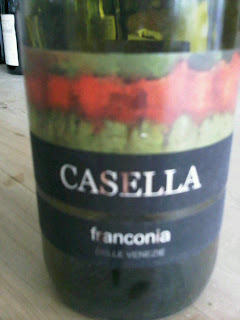Now Adriano is an opera lover as well as a wine merchant of genius. He comes from Venezia and has a wonderful range of Vino Sfuso including
Rossi | |||
Cabernet Franc | 12,00 %Vol | Rosso rubino carico, profumo intenso, erbaceo, vinoso. In bocca robusto, vellutato, giustamente tannico. | |
Merlot Base | 10,50 %Vol | Rosso rubino con riflessi violacei. Profumi caratteristici di mora ed erba tagliata. In bocca vinoso morbido ed avvolgente, leggermente aromatico. | |
Incrocio Manzoni 6015 | 12,00%Vol | Rosso rubino trasparente. Tipici profumi erbacei uniti a sentori di frutta rossa matura. Elegante di stoffa sottile, persistente, tannico | |
Bordolese | 12,50%Vol | Rosso rubino intenso, profumo erbaceo ricco di citazioni fruttate. In bocca asciutto, complesso fresco e dai tannini equilibrati | |
Pinot Nero | 11,50%Vol | Rosso rubino non molto intenso. Elegante, molto profumato, delicato e speziato. In bocca beverino, fresco, floreale | |
Cabernet Sauvignon | 11,50%Vol | Rosso rubino trasparente, Profumi erbacei e sentori di frutta rossa matura. .Robusto, di equilibrata acidità. | |
Merolt riserva | 12,00 %Vol | Rosso rubino brillante. Sentori di marasca, e di more mature. Vellutato delicatamente acidulo, giustamente tannico. | |
Marzemino | 11,50%Vol | Rosso rubino acceso, brillante e trasparente. Profumi persistenti. In bocca secco, armonico con finale gradevolmente amarognolo. | |
Refosco | 11,5 % Vol. | Rosso con tendenza al violaceo. Vinoso fruttato, speziato. In bocca asciutto, fruttato e floreale, fresco e vellutato. | |
Bianchi | |||
Sauvignon | 12,00%Vol | Giallo paglierino con riflessi verdognoli. Aromatico e delicato al naso. Ricordi di melone, peperone, banana. In bocca asciutto, elegante, carezzevole. | |
Chardonnay | 11,50%Vol | Giallo paglierino brillante. Sentori di mela matura, melone. In bocca complesso, mielato elegante e armonico. | |
Pinot Grigio | 12,00%Vol | Colore da giallo paglierino intenso ad ambrato. Delicato e fine, fruttato con ricordi di pera. In bocca sapido delicatamente acidulo con finale appena amarognolo | |
Prosecco Spento | 10,50%Vol | Giallo paglierino. Vinoso e fruttato leggermente aromatico. In bocca rotondo, sentori di mandorla, gradevole e beverino. | |
Tocai | 11,50%Vol | Giallo paglierino con riflessi verdognoli. Fresco asciutto e sapido, sottile ed elegante. In bocca asciutto, armonico e sapido. | |
Incrocio Manzoni 6013 | 12,50%Vol | Giallo paglierino scarico. Profumi mediamente complessi floreali e fruttati. In bocca fresco elegante e beverino | |
Prosecco frizzante | 12,00%Vol | Vino da imbottigliare in primavera. Giallo paglierino con perlage abbastanza sottile e persistente. Profumi di crosta di pane, fiori di campo. In bocca elegante con una gradevole vena amabile sul finale. | |
Verduzzo | 10,50%Vol | Giallo paglierino con riflessi dorati. Vinoso, lievemente fruttato. In bocca armonico, fresco, persistente con gradevole nota finale acidula | |
Vini dolci | |||
Verduzzo Ramandolo | 11,50%Vol | Giallo dorato chiaro. Sentori di miele con delicata presenza di mandorla tostata. Sapore dolce, delicato, accattivante | |
We include the whole range because these wines represent not only the bargain of the century but also tremendous diversity and interest. We bouight the Refosco and Incrocio Manzoni. When we explained to Adriano that we were going to have to transport these bottles in hold luggage he sold us two beautiful bottles (which we subsequesntly used for olive oil) with metal caps which did the job of keeping in the wine without any leaks and maintaining its freshness.
Both vini sfusi were delicious. They were surely the new wine of the 2008 vintage which had just been distributed to these outlets. We asked Adriano how he kept the wine fresh in his demijohns and the answer was surprising; he doesn't use gas or vacuum. He know he can sell the contents of his demijohns each day.
Adriano also sold us three wines otherwise unknown to us, two of which subsequently turned out to be old friends. They were
Franconia delle Venezie' = Blaufraenkisch
A third wine from the Vallee d'Aoste (where French still rules) was Mayolet which turns out to be the parent, together with Petit Rouge of Cornalin.
In Milano we trawled through Peck's wine department but were warded off by the prices. In Venezia we visited the Wine Nazi (Qv) but he has moved to smaller premeses and so the choice is diminished. Typically neither he nor the other sellers of Vino Sfuso had anything like the selection of Per Bacco in Milan. We did however find a litre of Malbech at 'Al Canton del Vin' (Castello 3156) for 1.95 Euros which was also very 'novello' and delightful.
Arriving at the Aeroporto Marco Polo early with the express intention of having lunch with our friends at the Wine Bar there (surely the best in any airport in the world, not that there is much competition) we got into an arguement with the delightful people serving there over what was called Traminer on the wine list and Gewurztraminer which is what was poured for us. When we said what we wanted was Traminer we were told it was the same thing. Slotovino maintained Traminer is something completely different and a good-natured arguement ensued. We are happy to say that in a sense we were both right. There is an excellent entry in Wikipedia on the subject.
Good buys at the Duty Free shop included a Pinot Bianco and a Fiulano from Proietti, and a Bardolino from Fratta Pasini.







